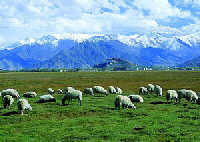| |
An Unpolluted and Beautiful City
( 2005-10-14 )
 The ancient city of Lhasa in Southwest China's Tibet Autonomous Region features blue skies, crystal clear river water, refreshing air, and a beautiful environment. It is the least polluted and most beautiful city in China and arguably the world. The ancient city of Lhasa in Southwest China's Tibet Autonomous Region features blue skies, crystal clear river water, refreshing air, and a beautiful environment. It is the least polluted and most beautiful city in China and arguably the world.
The Central Government invested 3.9 million yuan (what's the dollar amount?) to build a natural environment-monitoring station in August 1990. This was followed by the construction of 3 air-sample gathering stations, 5 environmental-noise monitoring stations, 27 traffic-noise monitoring stations, 6 drinking-water-sample gathering stations, and 3 water-quality monitoring stations. The time when the Tibetan environment was not monitored is over.
Monitoring results show that the Lhasa area is basically free from pollution, with the carbon dioxide density in the air being less than 0.1 mg (milligram), much lower than the national standard. In the downtown area, which is densely populated, the air contains slightly more soot than the other areas, a result of Buddha worshipping activities. Still, the soot content of the downtown air nevertheless remains below 0.4 mg per cubic meter. The Lhasa River is free from lead, zinc, copper, and other metallic trace elements, and towns and villages on both banks of the river cause no pollution to the river.
The Tibet Autonomous Regional Government and the Lhasa government have been planting trees in Lhasa for decades. Statistics gathered in 1991 show that the green area in the city covers 669.7 hectares, including 50.2 hectares of parks, 336 hectares of lingka woods, 233.3 hectares of lawns and flower beds, 13 hectares of seedlings, and 37.2 hectares of trees and lawns flanking roads. The greenery averages 12 square meters, ranking among the first in all of China.
The three-river project, the system for the development of the valleys in the middle reaches of the Yarlung Zangbo, Lhasa, and Nyang Qu rivers, brings benefit to the whole area of Lhasa. Several 100-hectare forests or tree belts have been built in the Nyemo Mountain gully and Painbo River valley, as well as along the Lhasa River banks.
|
|

